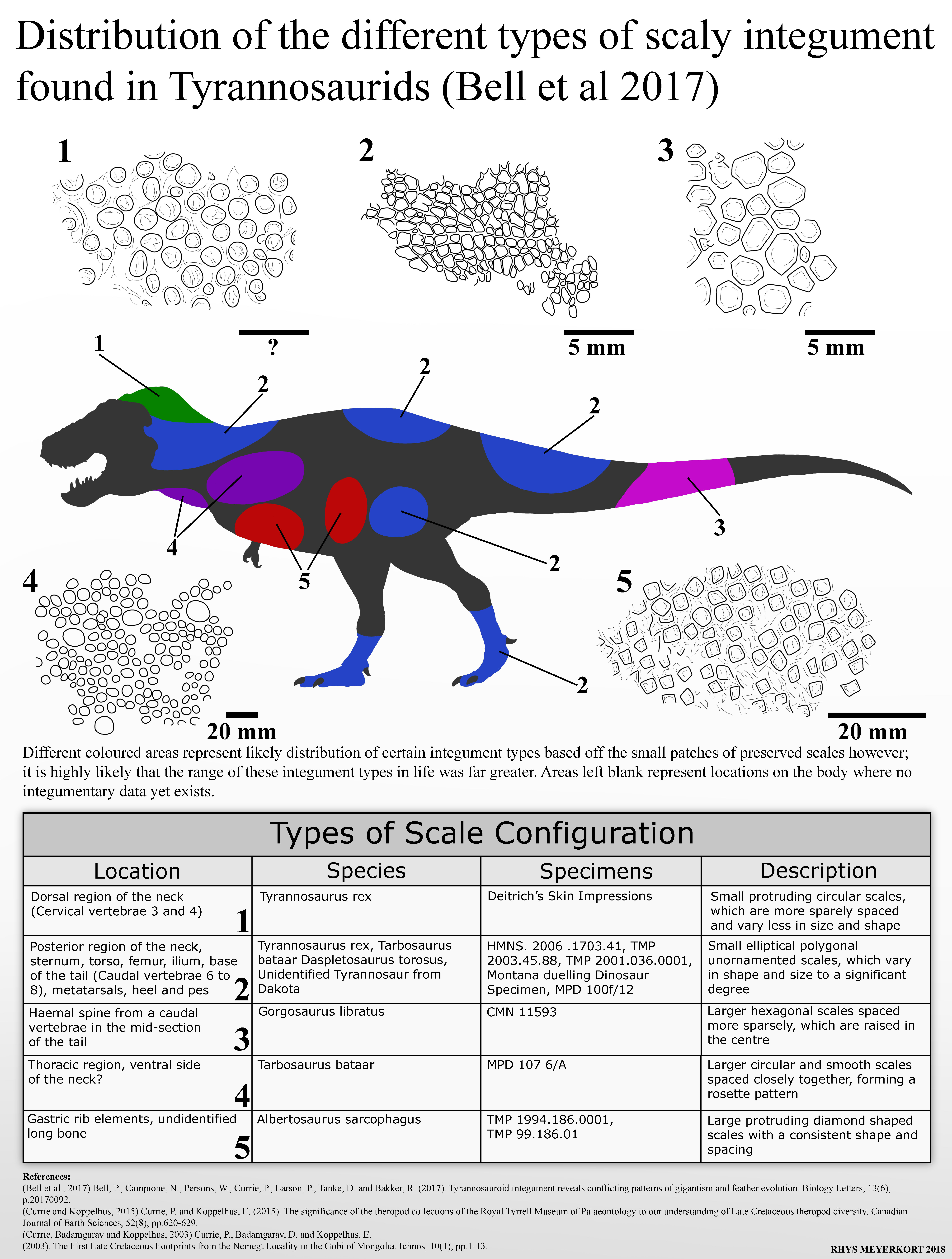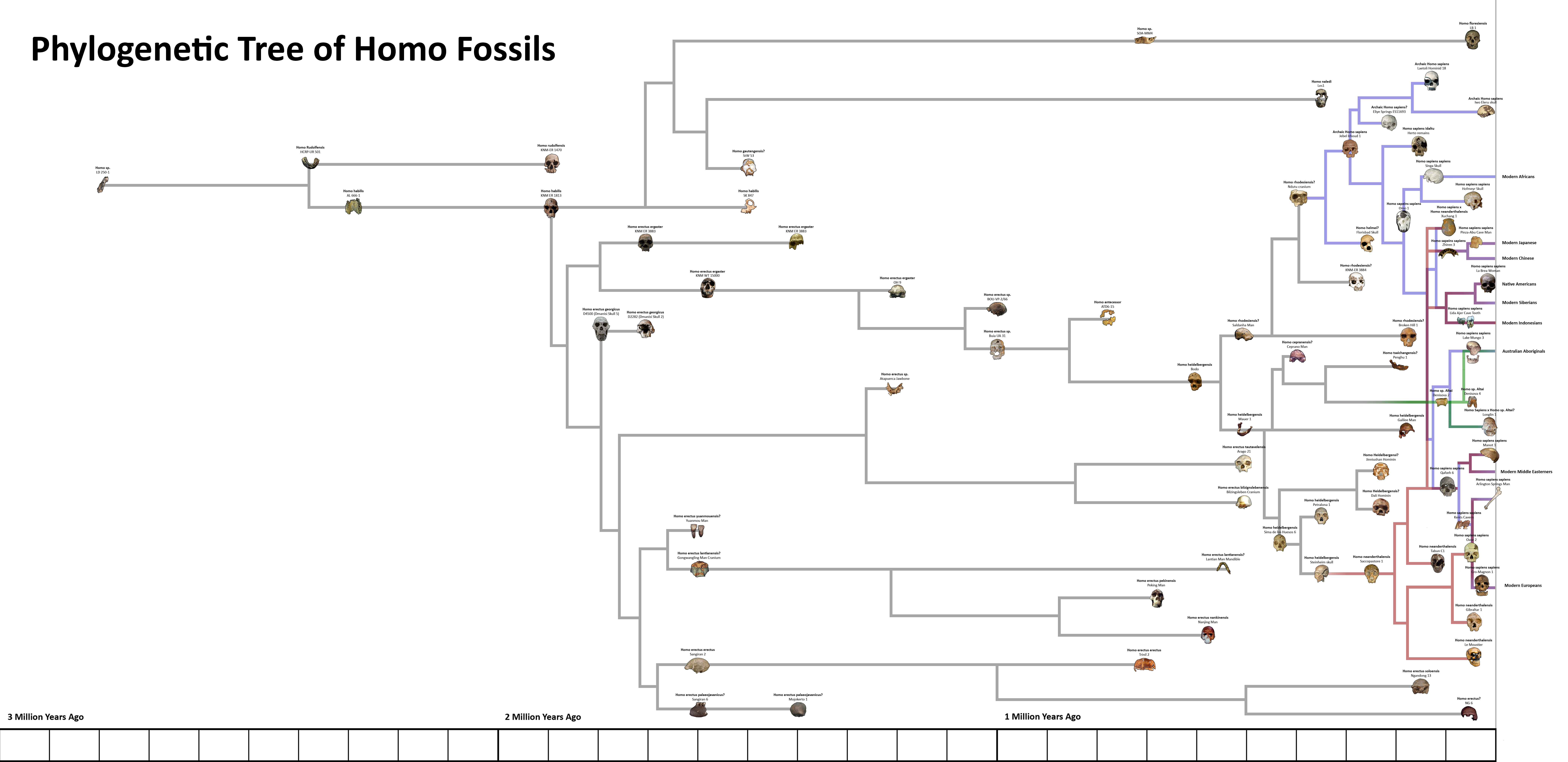HOME | DD
 Paleonerd01 — The Scale Types of Tyrannosaurids
Paleonerd01 — The Scale Types of Tyrannosaurids

#chart #albertosaurus #daspletosaurus #daspletosaurustorosus #gorgosaurus #paleoart #paleontology #tarbosaurus #tyrannosaurus #tyrannosaurusrex #tyrannosaurusskin
Published: 2018-12-15 14:26:29 +0000 UTC; Views: 19190; Favourites: 227; Downloads: 59
Redirect to original
Description
This chart is meant to illustrate the variation in the types of scaly integument possessed by large Tyrannosaurids such as Tyrannosaurus rex, Tarbosaurus bataar, Daspletosaurus torosus, Albertosaurus sarcophagus and Gorgosaurus libratus. As you can see, the types of scales and their patterns actually vary to a significant degree and even so on the same animal. For example the scales on the dorsal side of the neck of T. rex are very different to the scales found on the rest of the body. Because there is such limited data for each of the five species referenced here, it can therefore be inferred that these different types of scales were possessed by all five different species. Alternatively, it is also possible that each different scale type was unique to certain species, for example, the hexagonal scales found on the tail of Gorgosaurus may have only been possessed by Gorgosaurus and no other Tyrant species. Or they may have been possessed by all of them, with such limited data it’s impossible to accurately tell. Note all the different types of integument show tiny scales it the largest only being around two centimetres in diameter so from a distance the skin of these animals would have looked like leather rather than lizard skin. This chart includes reference to all published and unpublished integument preservation in Tyrannosaurids including the grey literature Tarbosaurus impressions. I hope this chart will come in handy to anyone hoping to accurately restore the skin of these animals, just remember how small the scales are though.
As for the types of scales found, on the dorsal region of the neck of Tyrannosaurs rex there are several impressions from the Deitrich specimen which show small protruding circular scales, which are more sparely spaced apart and are consistent in size and shape. Over the rest of the body of Tyrannosaurus rex there are small elliptical polygonal unornamented scales, which vary in shape and size to a significant degree. These are preserved on the specimen HMNS. 2006 .1703.41, as well on the Montana duelling Dinosaur Specimen. They are also seen on the foot and heel of the Tarbosaurus specimen MPD 100f/12 and on the lower torso region of the Daspletosaurus specimen TMP 2001.036.0001. On the tail of the Gorgosaurus specimen CMN 11593 there are these strange hexagonal scales which are pretty big and more sparsely spaced. Around the gastric ribs and on an unidentified long bone of the Albertosaurus specimen TMP 1994.186.0001 and TMP 99.186.01 there are these diamond shaped scales, which are evenly spaced and are consistent in size. On the thoracic region of the Tarbosaurus specimen MPD 107 6/A there are these large circular and smooth scales spaced closely together, forming a rosette pattern. No scale impressions yet known from the skull region however, it has been suggested that the osteology there either correlates to crocodilian like facial integument or large ornamental scales.
I would like to thank Joshua Ballze for assisting me in putting this together as he was a huge help in gathering photos and helping me describe each scale type. .
References:
(Bell et al., 2017) Bell, P., Campione, N., Persons, W., Currie, P., Larson, P., Tanke, D. and Bakker, R. (2017). Tyrannosauroid integument reveals conflicting patterns of gigantism and feather evolution. Biology Letters, 13(6), p.20170092.
(Currie and Koppelhus, 2015) Currie, P. and Koppelhus, E. (2015). The significance of the theropod collections of the Royal Tyrrell Museum of Palaeontology to our understanding of Late Cretaceous theropod diversity. Canadian Journal of Earth Sciences, 52(8), pp.620-629.
(Currie, Badamgarav and Koppelhus, 2003) Currie, P., Badamgarav, D. and Koppelhus, E. (2003). The First Late Cretaceous Footprints from the Nemegt Locality in the Gobi of Mongolia. Ichnos, 10(1), pp.1-13.
(Carr et al., 2017) Carr, T., Varricchio, D., Sedlmayr, J., Roberts, E. and Moore, J. (2017). A new tyrannosaur with evidence for anagenesis and crocodile-like facial sensory system. Scientific Reports, 7(1).Impressions from Tyrannosaurus, Tarbosaurus, Albertosaurus, Daspletosaurus and Gorgosaurus.
Tyrannosaurus
Tarbosaurus
Albertosaurus
Daspletosaurus
Gorgosaurus
Related content
Comments: 38

After doing my own research into Tarbosaurus integument, I can say that you've gotten some things wrong on this chart. For starters, the Mongolian Paleontological Center currently uses the acronym MPC-D instead of MPD for their dinosaurs. The extent of integument known from MPC-D 100F/12 is greatly exaggerated here, as it only preserves impressions from the sole of the foot. The scale type of MPC-D 100F/12 is also incorrect, as it shows pebbly scales similar to MPC-D 107/6A and not polygonal scales similar to Wyrex. The extent of MPC-D 107/6A is exaggerated as well, since it only preserves two small patches of impressions 6x8 cm and 5x7cm. I'm not sure where the picture you have labelled as Tarbosaurus in the description came from, but it certainly isn't MPC-D 107/6A.
👍: 0 ⏩: 1

Additionally, the exact type of integument found around the throat is unknown and that specimen was not collected.
incertaesedisblog.wordpress.co…
👍: 0 ⏩: 0

What important to understand is there aren’t really any entirely accurate reconstructions of extinct animals only ones which are supported by the evidence. So it’s not really honest to say one thing is more accurate than another when there is so little conclusive evidence. But in terms of this reconstruction and how close it might be to the real animal; there probably shouldn’t be scutes on the feet based of the dueling dinosaurs impressions, the scale texture looks pretty good. I personally would chose to go with lizard like extra oral tissue and large ornamental scales on the maxilla but this interpretation is also valid.
👍: 0 ⏩: 0

How can you get any more deviant than this...a drawing of skin samples locations from a Rex.
👍: 0 ⏩: 0

So basically this means little to no room for feathers?
👍: 0 ⏩: 2

I guess this means we’re officially done with feathers for this guy.
👍: 0 ⏩: 0

Not necessarily, there is still the possibility of a spares covering of feathers along the dorsal side but given the evidence currently available its not very likely.
👍: 1 ⏩: 1

also note a lot of these have a lot of space between the scales, which is what i did not know and i assumed they were all tightly packed like in the second sample
👍: 0 ⏩: 2

Tyrannosaur skin impressions are detailed enough preserve structures down to about a millimeter, which isn't bad. Fuzz would be finer than that, sure, but the scalation that has been preserved is packed so tightly there's no space for even fine fuzz. The impression on for example Wyrex's tail preserved veins or joints between units of scales so closely packed they had to move as a unit, and there's no sign of any follicles that would indicate "feathers" or similarly fibrous integument. Dont forget that Skin impressions is actually a direct casting of the animal laying down if there was "filaments" we would have seen this by now.
👍: 0 ⏩: 0

Very true however with the case of the Albertosaurus skin that is slightly due to weathering of the sample.
👍: 0 ⏩: 1

yeah but its still weird
👍: 0 ⏩: 1

Well made. But there is more undescribed Tyrannosaurus skin not illustrated in neither Bell et al or the reviewed by Joshua.
Unfortunately it looks like this wont see the light in a long time in similar fashion to BM.
👍: 0 ⏩: 1

Online there are a few images of some more skin apparently belonging to Tyrannosaurs floating around but it’s not even known if they actually belong to a Tyrannosaur they could be Hadrosaur skin impressions. Since their location is completely unknown I have chosen to leave them absent but its likely i'll refer to them in the future.
Impressions like this one which online is labeled as Tyrannosaurus skin but there is no way to verify it or know where it came from.
👍: 0 ⏩: 1

Absolutely. But i was talking about a quite resent collected Tyrannosaur specimen with skin preservation.
👍: 0 ⏩: 1

What specimen are you refereeing to?
👍: 0 ⏩: 1

A private collected one. Therefore it will be stuck in a warehouse for a long time wich would be in similar fashion to BM.
👍: 0 ⏩: 1

That really sucks doesn't it. What was your source on the information concerning this specimen?
👍: 0 ⏩: 1

Private collector wich name i wont reveal. But i might be able to provide a picture of it. Yes it is a bummer because it needs to be studied and associated with affiliated museum.
Side note Paul Sereno also claims he got T.rex skinn in his disposal wich he never published.
👍: 0 ⏩: 1

Its a real bummer there is so much info out there that is just out of reach. If you could provide a picture though I'd greatly appreciate it.
👍: 0 ⏩: 0

I wouldn't include the Tarbosaurus "throat skin" if I were you because it is based on a single, unverifiable anecdote from over 20 years ago.
👍: 0 ⏩: 1

Very dubious indeed however I did specify this.
👍: 0 ⏩: 1

I must have missed it, but where is the disclaimer on this?
👍: 0 ⏩: 1

“This chart includes reference to all published and unpublished integument preservation in Tyrannosaurids including the grey literature Tarbosaurus impressions.“ didn’t specify on the actually image however
👍: 0 ⏩: 0

That's what the direct evidence in Tyrannosaurids suggest however filamentous integument preserved in Tyrannosauroids could indicate that these larger Tyrannosaurs still retained some sparse feather covering maybe along the back.
👍: 0 ⏩: 1

Was it like a whole sheet or blanket or sprinkled around the back every now and then?
👍: 0 ⏩: 1

The whole body would have been covered in life, the coloured regions on this diagram represent the inferred range of each scale type based off the small impressions we currently have. Of course it’s assumed the extended further.
👍: 0 ⏩: 1

interesting chart
btw, did you know that there is a skin impression similar to that of a plucked chicken?
dml.cmnh.org/2001Oct/msg00538.…
this is the reference i got when i asked another Paleoartist and friend on the same topic
👍: 0 ⏩: 1

While the scale impressions from HMNS. 2006 .1703.41 may at first superficially appear to be similar to the naked skin of a chicken, structurally they are different and its almost certain these impressions show scaly as opposed to naked skin.
👍: 0 ⏩: 1



























